Author: Kyle
Translated by: Deep Flow Tech
"Internet Capital Markets" has multiple meanings. In today's context, it refers to "alchemical" results that are entirely derived from the advantages of blockchain technology: a form of fintech that transcends geographical boundaries. From collateralized lending using "magical internet currency" to the tokenization of government bonds and private credit, to the application of stablecoins—these are all seen as manifestations of the "internet capital market" in today's world where traditional finance and digital assets intersect.

Original tweet link: Click here
However, for those of us who have been deeply engaged in this asset class as on-chain traders over the past few years, the "internet capital market" has another layer of meaning. It not only refers to "on-chain government bonds" but also encompasses various speculative tools such as NFTs, decentralized finance (DeFi), and ICOs, along with the token trading derived from these tools. This all began with the deployment of the first smart contract on Ethereum in 2015, driving the birth and development of countless innovations over the past decade.
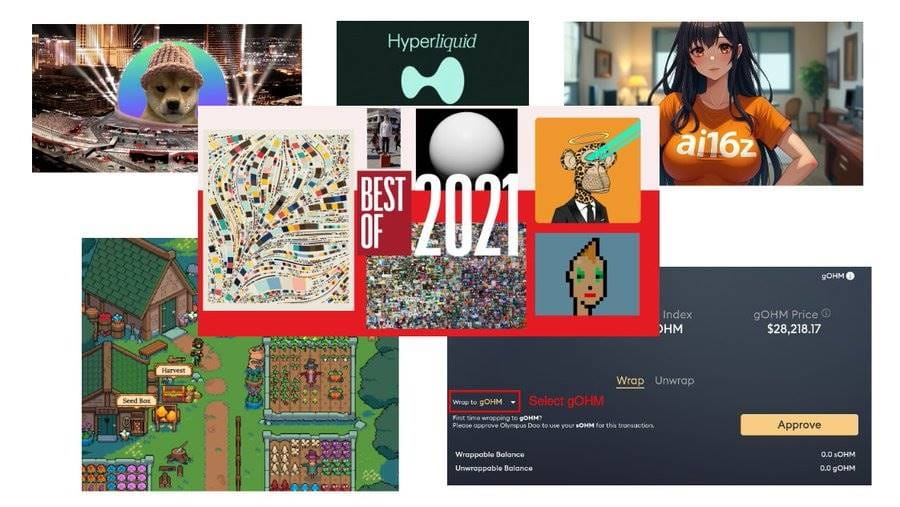
In this article, I hope to delve into this aspect of the internet capital market—focusing on tokens, narratives, 10x or even 100x returns, airdrops, etc., as these mechanisms constitute the original core philosophy of the internet capital market.
I believe we are on the verge of a new phase, which seasoned crypto players might call "a new meta." To delve into this, we must first observe these capital formation mechanisms and the differences that come with them:
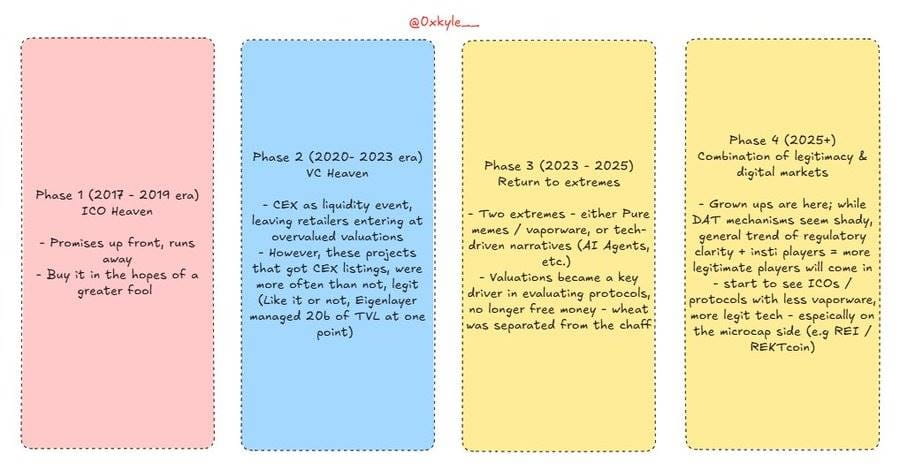
If the content looks too small, you can click the image for details!
Over the past several cycles, we have witnessed the continuous evolution of market financing mechanisms. From Initial Coin Offerings (ICOs), to centralized exchange altcoins (CEX Alts), to meme-centric tokens, I have broken it down in the chart above, but simply put:
1. Initial Coin Offering (ICO) Era (2017)
A mechanism of investment based on promises, where investors hope to find "a bigger fool" to take over. The situation where technology truly lands is extremely rare; even if the technology exists, most of it is difficult to apply in practice or unable to create value.
In most cases, this is more like a game of "hot potato." For example, projects like Bitconnect and Dentacoin are typical cases from this period.
2. Venture capital paradise.
The bubble of 2021 brought in a lot of institutional capital, which, in hindsight, has caused significant damage to the industry. Extremely high valuations and poor incentive designs (who would work hard after receiving a $100 million advance?) led to frequent problems.
However, this wave has also spawned more legitimate and mature products, so we cannot completely negate the mainstream model of low liquidity and high fully diluted valuation (FDV). Although the valuations of these tokens are extremely inflated, they have also driven the birth and development of some important protocols that are now well recognized.
Take Ethena as an example—I really like it, but it is undeniable that the simple mechanism of "giving too much too early" weakened its ability to "increase token prices" from the start. However, there is no doubt that it is one of the best products in the crypto space. This phenomenon is similar to many other "double-edged sword" projects.
This period also saw the birth of many projects like Solana and Uniswap. Although there are some controversies surrounding the operational methods of these projects today, the fact is that this era is not entirely negative, and cannot be generalized.
Is there a way to avoid these problems? Perhaps there is. But in the end, these are just growing pains of the industry—despite the fact that four years have passed, we are still bearing the impact of these aftereffects.
3. Both sides—returning to extremes.
After the collapse of FTX, the crypto space fell into an existential crisis, and this sentiment is evident. Many began to adopt the viewpoint that "crypto is a scam," believing that most projects are merely tools for quick wealth. I once shared this view, but it is important to understand the nuances.
Although the crypto space has a "casino" nature, it does not mean it is entirely a casino. Stablecoins and asset tokenization are proving their immense practical applications beyond the launch of a multitude of memecoins and as dollar trading pairs for long-tail assets.
In this era, the nature of projects entering the market is clearly differentiated. On one hand, there are purely meme projects (like Dogwifhat, Pepe), and on the other, there are more legitimate narratives, such as AI agents. Even though valuations have significantly declined, you might ask yourself, "Is all of this just a meme?" But just because they are viewed as memes does not mean they will always be memes.
This field is undergoing a slow maturation process. Some projects have already transitioned from the threshold of being memes to legitimacy—like REI.
In the end, the mindset that "everything is a meme" may be extremely destructive in the coming years because:
4. The combination of legitimacy and the digital market.
We are entering an "era of maturity." Institutional capital has entered the scene and is showing great interest. However, perhaps because we are too close to the "factory" and understand "how sausages are made," this has led to many perplexing outcomes. For example, people in the crypto space are pessimistic about Circle's IPO because they are all too aware of the potential risks and negative bear market theories involved.
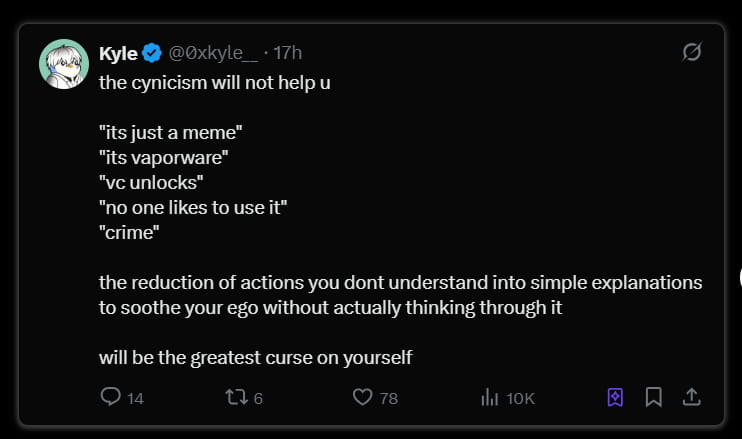
Original tweet link: Click here.
Knowing too much can actually be a curse. For this reason, the cynical mindset of "everything is a meme" can ultimately cause great destruction, as casually dismissing everything can lead you to lose faith.
Take Ethereum as another example. This was the worst-performing asset for two consecutive years, and many large holders chose to cut their losses and exit. It was branded with various negative labels, even leading us to sincerely believe that decentralization had failed and that Ethereum would never see a bright future again.
Look at Ethereum now. Do you think Tom Lee would know (or care) about the embarrassing videos of the Ethereum Foundation leadership singing on stage? Do you think institutions like BlackRock—who have already launched tokenized funds on Ethereum—would care about the so-called "weak mentality" of the Ethereum Foundation?
The answer is no. This is what we must internalize. Nowadays, the crypto space seems to have forgotten how to dream, while traditional finance (Trad-Fi) is relearning how to chase dreams. As digital assets gradually become mainstream, attracting more high-quality developers, this will inevitably bring more opportunities.
This is what I refer to as the "internet capital market." We are entering an unprecedented era of potential in the past five years—where regulation, technological strength, and capital are perfectly integrated. A part of this will inevitably move on-chain. It is no exaggeration to say that I believe some of the most valuable companies in the coming years will choose to issue tokens on-chain.
In fact, this has already become a reality. Hyperliquid is the pinnacle representative of the internet capital market. They did not accept any venture capital (VC) funding, and to my knowledge, there is also no equity structure—it's purely an on-chain token that rose rapidly from zero and dominated the market, now moving towards an annual revenue of $1 billion. This is the purest manifestation of how the internet capital market operates.
Let me emphasize once again, this is the true meaning of the internet capital market.
Hyperliquid is a company valued at $40 billion, with no business plan and no equity burden. It is a purely on-chain giant that rapidly rose from zero and dominated the market, now moving towards an annual revenue of $1 billion. This is the purest manifestation of how the internet capital market operates.
But before you think this is just an article supporting Hyperliquid, let me take a step back. I believe this is not just the story of Hyperliquid. In the coming years, we will see more similar cases.
Doesn't that sound exciting? We are about to enter an era full of opportunities—don’t let your cynical mindset destroy past dreams. However, what saddens me the most is that all of this is obvious to anyone truly observing the trends, yet we are busy chasing random altcoins' 50% gains because the market of the past four years has accustomed us to this pattern. It’s time to set our sights on bigger dreams—the successful blueprint is already laid out before us.
In a chance conversation, I discussed the following with @connorking_ (I am fortunate to call him a good friend):
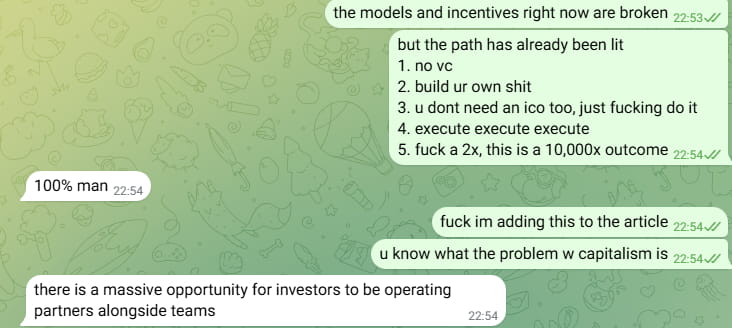
Huge opportunities are coming: investors can work alongside teams and become operational partners.
Today, the shackles that bound us no longer exist. For too long, people have been constrained by traditional structures, but in the era of the "internet capital market," owning 5%-10% of your own token and building it into a product worth $100 million or $1 billion will yield returns far beyond most people's expectations.
Yes, financing is still necessary; yes, doing an ICO is not wrong. But look again at Hyperliquid's successful path—if you are confident in your product, this is a direction worth emulating. And look at the wealth of Hyperliquid's founders today; they did not rely on venture capital but simply held a significant portion of their product and listed it in the internet capital market. The market, as the arbiter of truth, will reward you handsomely if it recognizes your product.
Do you know what the problem with capitalism is? Most participants in capitalist markets have a short-sighted view. Capitalism can indeed drive innovation in the right direction but not far enough. People often compromise for quick profits, but if they are willing to hold out for a few years, they may reap greater rewards. This is the true embodiment of the mathematical power of compounding.
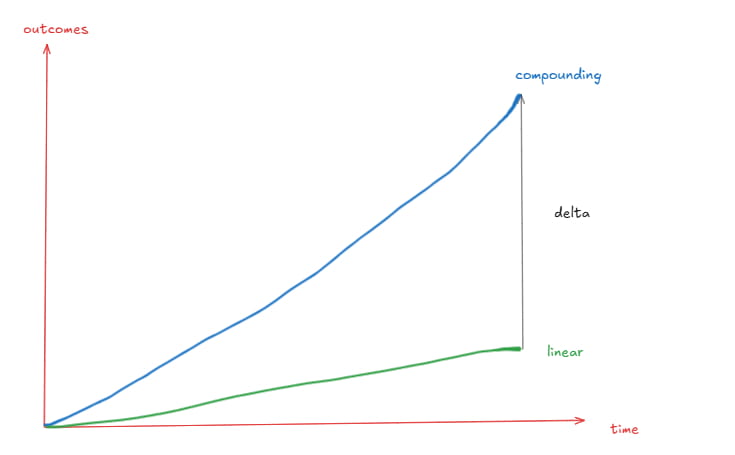
Long-term thinking often results in geometric rather than arithmetic changes in outcomes—for example, doubling in two years (2x), growing fivefold in four years (5x), and tenfold growth in five years (10x).
Of course, you could make $10 million by quickly launching a product and then abandoning it, but if you are willing to spend a few more years refining that product, you might make $300 million.
Finally, I want to talk about the speculative nature of the market. Undoubtedly, the market is more like a voting machine in the short term. We will still see many "worthless" assets' prices rise, and we may also see the prices of "quality" assets far exceed their fundamental values. Phenomena like team sell-offs may still occur.
But the key is that the upcoming wave of digitization will attract more genuinely outstanding founders to the battlefield—this is the trend shift I foresee, which will drive the creation of many great on-chain products.
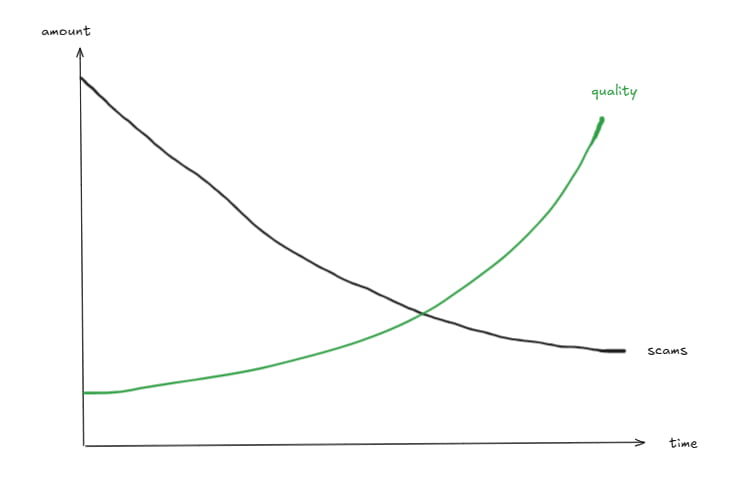
More S/A-level founders participating = Less attention to C-level and below founders = Less focus on those "air projects", more focus on truly high-quality products that can bring compound growth.
Similar to the trends mentioned above, it will never go to zero, but it does not need to go to zero. Look at Hyperliquid, look at Ethena, look at Aave—annual income of $1 billion, stablecoin total locked value (TVL) reaching $10 billion, net deposits as high as $60 billion. And then look at Pengu and Rekt—total views reaching 197 trillion, 2 million toys sold globally, beverage brands entering the shelves of 7-11 in the U.S., all of which have issued tokens through blockchain.
Certainly, we can argue whether they are overvalued or undervalued. But I would rather discuss these issues than return to an era where one could only invest in companies making empty promises with no real results. I would prefer to own a piece of something real rather than pretend to play a game of "hot potato."

Another perspective on interpretation—from @ImmutableSOL.
If you always think of every token as a "meme," then that viewpoint loses its meaning. Talented individuals like Jeff from Hyperliquid issuing tokens is no longer a fantasy. The next "Steve Jobs" could very well issue tokens on-chain. Some of these assets will ultimately become on-chain giants that define the future of finance, and we all have the opportunity to participate. Simply viewing them as "just a meme project" could mean missing out on 1000x returns.
This is what I mean by the evolution of speculation. We have evolved from trading worthless air projects to being able to own shares of solid, durable, and most importantly, on-chain assets—these assets will shape the world.
It's time to believe. Believe in the possibilities of the future, rather than being burdened by the shackles of the past. Break free from the chains of history and turn your bearish sentiments into ashes. The future is bright, my friends. We cannot let the shadows of the past obscure our optimism for the future.
Ladies and gentlemen, to me, this is what the future looks like: Internet. Capital. Markets.
Editor's note on long-term results:
Japan is renowned for its excellent quality, but this quality is not achieved overnight; rather, it is the accumulation of decades of culture, products, and lifestyle. If they had simply "optimized for profit," they likely would not have come this far. But because they have had decades of long-term planning, they are now reaping the rewards. The results of this long-term thinking cannot be fully quantified by numbers—clean streets, cool vending machines, though they may not directly reflect in "GDP", attract a large high-consumption demographic and bring revenue to the country.



